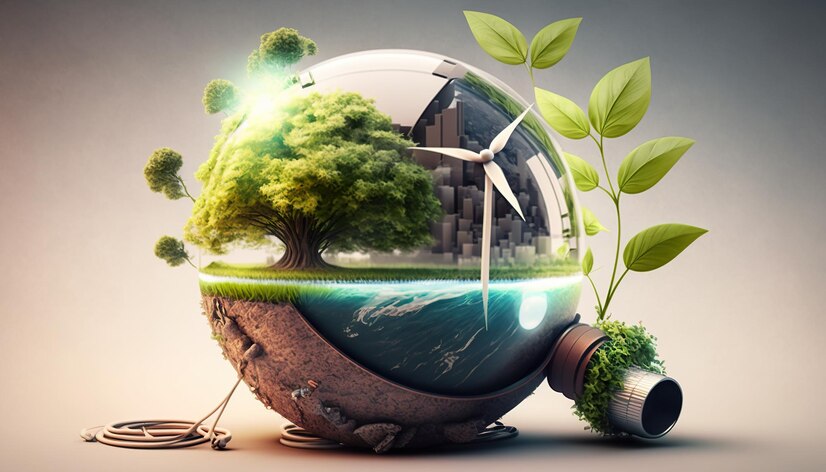Renewable Energy: The Sustainable Future for Mankind
“The Earth has enough resources for our
needs but not for our greed.” Yes! The greed of mankind is endless. The
thought of Mahatma Gandhi is eternal. The unfavourable perception needs to be transformed
into something innovative. As a result, humankind attempts to concentrate on
renewable energy. By definition, renewable energy comes from unlimited,
naturally replenished resources, such as the sun, tides, and wind. It can be
used for electricity generation, space and water heating and cooling, and
transportation. Renewable energy is generated from natural resources, which can
be renewed more easily than when they are used. The vital part of sustainable
energy transition to these renewable energy sources is significant for the
fight against climate change.
In India, lots of
subsidies and incentives help make it easier for people to lean on renewable
resources as a stable source of power to help alleviate the climate crisis.
Moreover, clean energy requires more than just incentives; it needs innovative
technology to improve energy efficiency. Due to this power generation, the
world’s reach for net-zero emissions will accelerate.
Why Renewable Energy?
A few years ago, renewable energy had never been a topic of more discussion or debate than it is today. Lots of governments, organisations, businesses, and individuals all around the world are aware of the need for more renewable energy. Renewable energy offers numerous socio-economic and environmental advantages, which include:
- Reduced carbon emissions and air pollution due to energy production.
- Increased power grid resilience, security, and dependability.
- The production and manufacture of renewable energy technologies will increase job opportunities.
- Lower expenses for energy.
- Increased energy access for remote, coastal, or isolated communities.
Which is the best renewable energy source?
Depending on the geographical conditions and resource availability, each of the locations may profit from various renewable energy sources. The most effective clean energy source for the future, factors like efficiency, cost, and environmental impact (pollution, climate change, etc.,) should be taken into account. Solar energy and wind energy are the two clean energy sources, and both are becoming more popular for both residential and national grid production. For residential and national grid production, solar energy and wind energy are the most popular clean energy sources.
These two renewable energy sources have promise for the future; both in terms of their ability to provide clean energy with zero emissions and also boost local economies. While rooftop solar panels give to potential long-term option the installation prices are still very costly. Wind power offers a significant rise in funding and local employment. Over the next four years, the capacity of renewable energy is expected to increase by 50% with hydropower, wind power, and solar power leading the way.
Renewable Energy in Urban and Rural India
Due to its vast landmass and abundant sunshine and wind resources, India has great potential for renewable energy. Here’s how we can promote its utilisation in both urban and rural areas: by investing in infrastructure and technology, encouraging businesses and individuals to adopt renewable energy practices, and educating the public on the benefits of clean energy sources.
Urban Utilisation:
- In India, you may get financial incentives by selling excess solar power back to the grid under net metering rules. Subsidies and tax advantages for rooftop solar installations can also help to reduce costs.
- Stricter building codes should be implemented to require or promote energy-efficient features and the pre-installation of solar panels in new construction.
- Green Financing: Make rooftop solar investments accessible to people and housing societies through simple loans and financing programmes.
- Public awareness: Workshops and campaigns can inform urban residents about the advantages and financial viability of renewable energy, encouraging them to switch to it.
Rural Utilisation:
- Micro-Hydropower plants of modest size situated along rivers or canals can supply rural areas with clean electricity.
- The utilisation of biogas plants, which transform organic waste into clean cooking fuel and enhance health by lowering reliance on firewood, should be encouraged.
- To improve safety and security in off-grid communities, provide reasonably priced streetlights and solar lanterns.
- Create local job opportunities through skill development. Teaching young people living in rural areas how to install and maintain renewable energy systems.
- Create mini-grids that run on biomass, solar, or wind energy to supply dependable electricity to isolated communities.
Current Statistics:
India has come a long way in terms of renewable energy, but more can yet be done to ensure access to clean and reliable energy for all citizens.
- Share of Renewable Energy: By 2023, renewable energy will account for about 33% of India’s total power generation capacity.
- India is considered a global leader in solar energy. Because here’s an installed capacity exceeding 175 GW. However, the popularity of rooftop solar in cities is still low.
- Some areas continue to lack sufficient power yet; even though rural electrification has made significant progress. This gap can be filled by sustainable energy easily.
India can speed up its transition to a clean and sustainable future by implementing these strategies and staying up-to-date on the latest developments. It is equally benefiting both urban and rural communities. While Godrick’s focus seems broad, its emphasis on social responsibility aligns well with the growing renewable energy sector. To help create a more sustainable and cleaner future, Godrick might be able to use its expertise in strategic investment to fund creative renewable energy projects.



